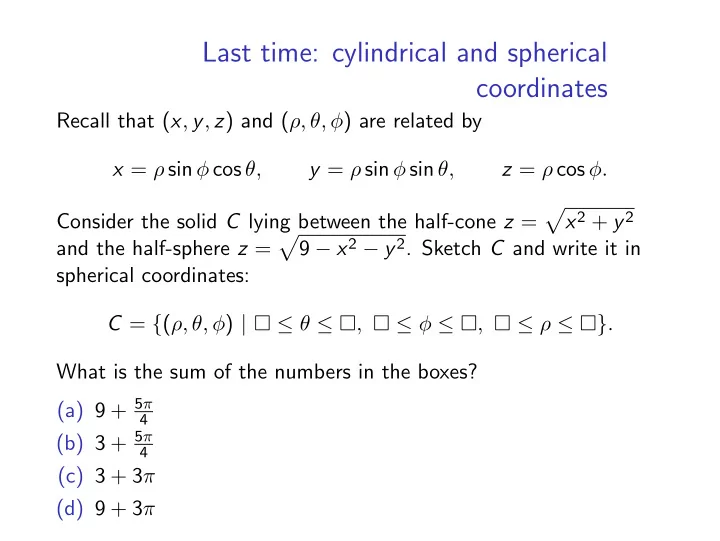

Last time: cylindrical and spherical coordinates Recall that ( x , y , z ) and ( ρ, θ, φ ) are related by x = ρ sin φ cos θ, y = ρ sin φ sin θ, z = ρ cos φ. x 2 + y 2 √︁ Consider the solid C lying between the half-cone z = 9 − x 2 − y 2 . Sketch C and write it in √︁ and the half-sphere z = spherical coordinates: C = { ( ρ, θ, φ ) | � ≤ θ ≤ � , � ≤ φ ≤ � , � ≤ ρ ≤ � } . What is the sum of the numbers in the boxes? (a) 9 + 5 π 4 (b) 3 + 5 π 4 (c) 3 + 3 π (d) 9 + 3 π
Announcements The American Society of Mechanical Engineers at the University of Illinois wants you to sign up for their talent show. Here is a link to their poster: Poster.
Recall: Integrating in spherical coordinates Let B be a “spherical wedge”: B = { ( ρ, θ, φ ) | α ≤ θ ≤ β, a ≤ ρ ≤ b , c ≤ φ ≤ d } . Let f : B → R be a continuous function. Then ∫︂∫︂∫︂ fdV = B ∫︂ d ∫︂ β ∫︂ b f ( ρ sin φ cos θ, ρ sin φ sin θ, ρ cos φ ) ρ 2 sin φ d ρ d θ d φ. c α a
Example Let’s find the volume of the solid C from the first question. C = { ( ρ, θ, φ ) | 0 ≤ θ ≤ 2 π, 0 ≤ φ ≤ π 4 , 0 ≤ ρ ≤ 3 } So we have ∫︂∫︂∫︂ V ( C ) = dV C ∫︂ 2 π ∫︂ 3 π ∫︂ 4 ρ 2 sin φ d ρ d θ d φ = 0 0 0 ∫︂ 2 π ]︃ 3 π ∫︂ [︃ 1 4 3 ρ 3 sin φ = d θ d φ 0 0 0 ∫︂ 2 π π ∫︂ 4 = 9 sin φ d θ d φ 0 0 √ π ∫︂ 4 = 18 sin φ d φ = 9 π (2 − 2) . 0
Practice with Jacobians Find the Jacobian for each of the examples (1), (2), (3). Which is the largest? (a) (1) (b) (2) (c) (3) (d) It’s a tie. (e) I don’t know how to do this.
Change of variables — why does it work? ∫︁∫︁ We calculate T ( D ) f ( x , y ) dA by dividing D into small boxes � of area ∆ A . Then T ( D ) is divided into small parallelograms T ( � ) of area | ∂ ( x , y ) ∂ ( u , v ) | ∆ A . We should choose test points ( x ∗ , y ∗ ) in each T ( � ). We do this by choosing points ( u ∗ , v ∗ ) in � , and taking ( x ∗ , y ∗ ) = T ( u ∗ , v ∗ ). Then to compute the integral, we take the sum over all the parallelograms of the contribution f ( x ∗ , y ∗ ) · Area( T ( � )) = f ( T ( u ∗ , v ∗ )) · | ∂ ( x , y ) ∂ ( u , v ) | ∆ A , and taking the limit as the number of boxes goes to infinity. D f ( T ( u , v )) | ∂ ( x , y ) ∫︁∫︁ But this is just the integral ∂ ( u , v ) | dA .
Recommend
More recommend